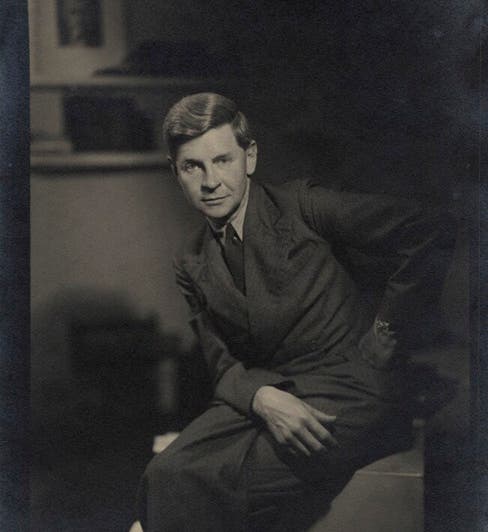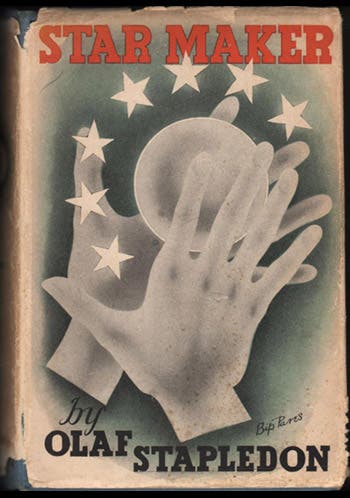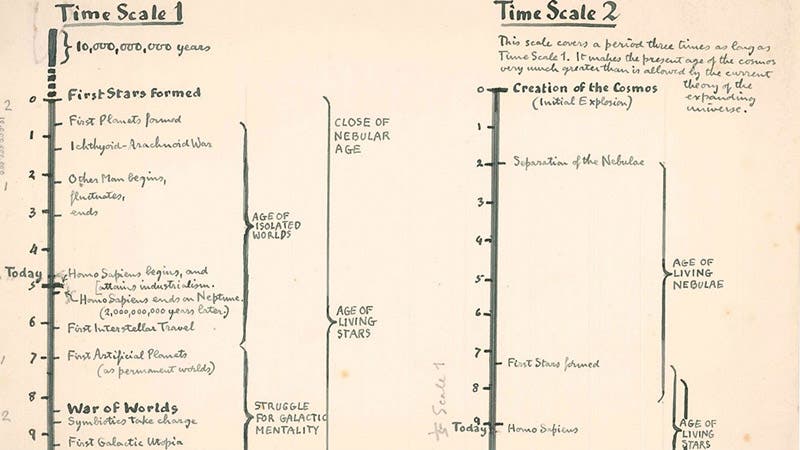Scientist of the Day - Olaf Stapledon
William Olaf Stapledon, an English philosopher and science fiction author, was born May 10, 1886. After Jules Verne and H. G. Wells, Stapledon was the most influential early writer of science fiction, and he was more thoughtful than either of his predecessors, since he had a PhD in philosophy to boot. He taught philosophy at the University of Liverpool for most of his professional life, and in 1930, he made his entry into the world of science fiction – at that time a very small world – with a novel, Last and First Men. It covered 18 human civilizations – ours being the beginning of the first – until humans were finally eliminated by the universe. He published several more books, and then, in 1937, Star Maker, which made the scope of the first book seem puny. In Star Maker, the consciousness of the main character visits another human mind on another planet, and together they mentally explore the cosmos, forming a larger and larger consciousness as they go, but still keeping their individuality. In this way, all manner of intelligent species are encountered, some who communicate by music, some who live on huge planets where gravity allows only the tiniest of beings, which have to form their own collective mind, some whose only awareness of the external world is through smell.
It has been a long time since I read Stapledon, and I didn’t like his books very much, the first time around. He was not a good writer, and he suffered from being a philosopher to boot, a severe if not malignant affliction. But over the years, I have noticed that many of my favorite science fiction writers hold Stapledon in high esteem, authors like Arthur C. Clarke and Stanislaw Lem. Stapledon did much to establish many of the important themes of later science fiction, such as the idea that intelligence might arise in swarms of otherwise inanimate matter, which was the basis for Lem's novel Solaris (1961) and the two films based upon it. Stapledon also proposed the "zoo hypothesis," the notion that the Earth is in effect the menagerie of an alien civilization, which studies us but does not interfere, and Stapledon gave us what later became the "Prime Directive" in Star Trek, that it is verboten to tamper with a pre-human civilization and do anything to help it find its way. In Star Maker, Stapledon even suggested that more advanced civilizations would eventually build structures around their suns that captured 100% of the energy given off by the sun. Freeman Dyson later elaborated on the details of such a "Dyson sphere", as it is now called. But Dyson himself often said it should be called a Stapledon sphere, since Star Maker was the source of the idea.
I finally decided I needed to reevaluate Stapledon when I discovered, only recently, that Jorge Luis Borges, the great Argentine writer, was fond of Stapledon, and reviewed his books enthusiastically when they first came out. Since Borges is my own favorite 20th-century author, his opinion was not to be dismissed, and I clearly needed to reconsider my position. Borges pointed out that Stapledon’s lack of skill as a prose stylist was, in his case, a great virtue, since he described the various civilizations that he imagined as a witness rather than a novelist, which gave everything great immediacy. I didn’t have enough advance notice to reread Last and First Men and Star Maker for this post. But I intend to do so before Stapledon’s next birthday rolls around. Meanwhile, I would enjoy hearing from others who have liked, or have not liked, his novels.
Stapledon’s manuscripts are at the University of Liverpool. Among his papers are several timelines that he sketched for his books. I include a detail from a sheet with two of these timelines, in case you want to see how to imagine the history of the universe on a grand scale (fourth image, just above).
Dr. William B. Ashworth, Jr., Consultant for the History of Science, Linda Hall Library and Associate Professor emeritus, Department of History, University of Missouri-Kansas City. Comments or corrections are welcome; please direct to ashworthw@umkc.edu.









